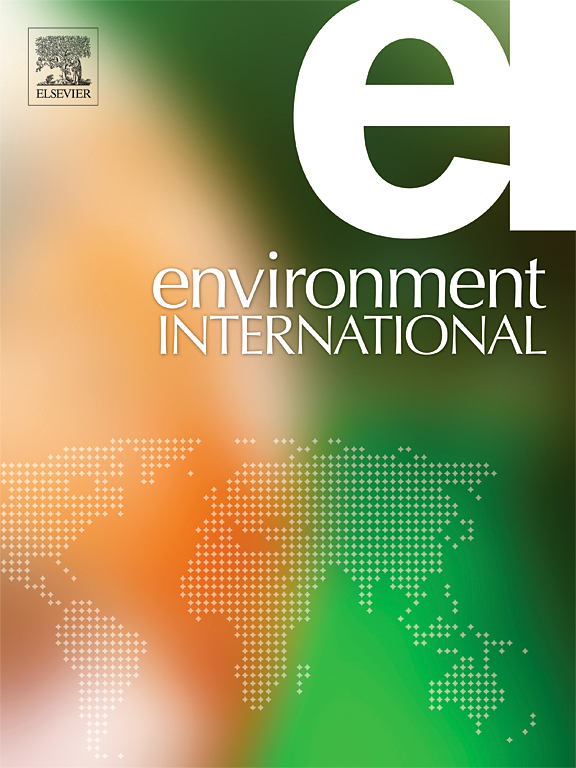Non-targeted screening of organic micropollutants in drinking water: Evidence of contamination from purification systems and plastic materials
IF 9.7
1区 环境科学与生态学
Q1 ENVIRONMENTAL SCIENCES
引用次数: 0
Abstract
Concerns over organic micropollutants (MPs) in drinking water are growing due to their persistence in aquatic environments and the limitations of conventional tap water treatment methods. Alternative pathways, including water purifiers, cause potential human exposure to MPs through drinking water. This study investigates potential human exposure to MPs through drinking water by analyzing five sample sets: (1) water from 12 campus purifiers, (2) water from tap and 2 purifiers over 12 weeks, (3) purified water from 21 public buildings, (4) bottled water from sources across Korea, and (5) sonicated water extract of purifier-filter-elements. All samples were pretreated via solid-phase extraction and then analyzed to identify MPs through suspect and nontarget screening using liquid chromatography high-resolution mass spectrometry. A total of 41 MPs were tentatively identified through MS/MS spectral pattern diagnosis, including plasticizers, plastic derivatives, organophosphorus flame retardants (OPFRs), pesticides, and pharmaceuticals. Among these, 24 MPs were confirmed with standards, 6 were quantified with standards, and 4 were semi-quantified without standards. Notably, four OPFRs were found in purified water (up to 3900 ng/L) and tap water (up to 130 ng/L). Additionally, plastic-derived PA6 oligomers were detected in purified water, with concentrations reaching 5300 ng/L. The presence of OPFRs and plastic-derived oligomers in household purified water was suggested to be linked to the water’s contact with plastic tanks and pipes, as well as the use of fiber wipers during purifier cleaning. The findings suggest the potential utility of non-targeted monitoring of drinking water and support its use to inform future targeted monitoring efforts.

饮用水中有机微污染物的非目标筛选:净化系统和塑料材料污染的证据
由于有机微污染物在水生环境中的持久性和传统自来水处理方法的局限性,人们对饮用水中有机微污染物(MPs)的关注日益增加。包括净水器在内的其他途径可能导致人类通过饮用水接触到MPs。本研究通过分析五个样本集来调查人类可能通过饮用水暴露于MPs的可能性:(1)来自12个校园净水器的水,(2)来自12个 周的自来水和2个净水器的水,(3)来自21个公共建筑的纯净水,(4)来自韩国各地的瓶装水,以及(5)净水器过滤元件的超声波水提取物。所有样品均通过固相萃取预处理,然后使用液相色谱高分辨率质谱分析,通过可疑和非目标筛选来鉴定MPs。通过MS/MS谱图诊断,初步鉴定出41种多聚物,包括增塑剂、塑料衍生物、有机磷阻燃剂、农药和药物。其中用标准品确认的有24种,用标准品定量的有6种,无标准品半定量的有4种。值得注意的是,在纯净水(高达3900 ng/L)和自来水(高达130 ng/L)中发现了四种opfr。此外,在纯净水中检测到塑料衍生的PA6低聚物,浓度达到5300 ng/L。据认为,家用纯净水中存在OPFRs和塑料衍生低聚物与水与塑料水箱和管道接触以及在清洁净化器时使用纤维雨刷有关。研究结果表明,饮用水非目标监测的潜在效用,并支持将其用于为未来的目标监测工作提供信息。
本文章由计算机程序翻译,如有差异,请以英文原文为准。
求助全文
约1分钟内获得全文
求助全文
来源期刊

Environment International
环境科学-环境科学
CiteScore
21.90
自引率
3.40%
发文量
734
审稿时长
2.8 months
期刊介绍:
Environmental Health publishes manuscripts focusing on critical aspects of environmental and occupational medicine, including studies in toxicology and epidemiology, to illuminate the human health implications of exposure to environmental hazards. The journal adopts an open-access model and practices open peer review.
It caters to scientists and practitioners across all environmental science domains, directly or indirectly impacting human health and well-being. With a commitment to enhancing the prevention of environmentally-related health risks, Environmental Health serves as a public health journal for the community and scientists engaged in matters of public health significance concerning the environment.
 求助内容:
求助内容: 应助结果提醒方式:
应助结果提醒方式:


